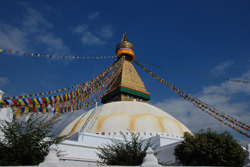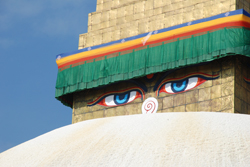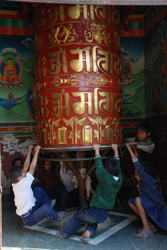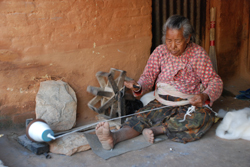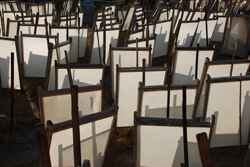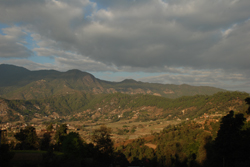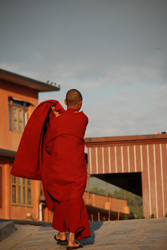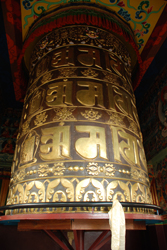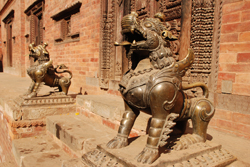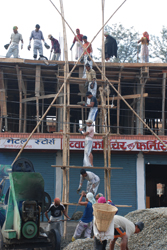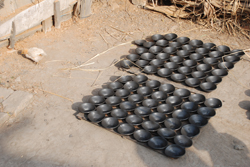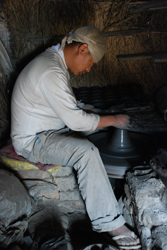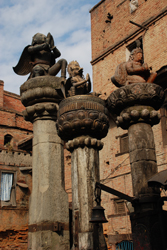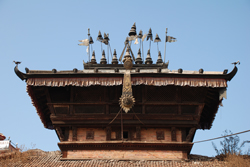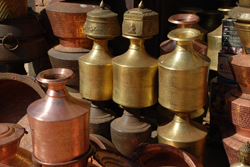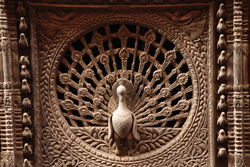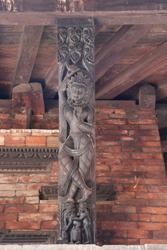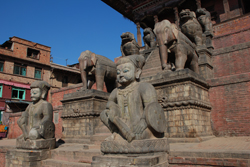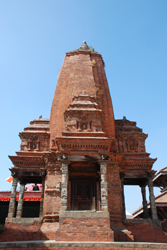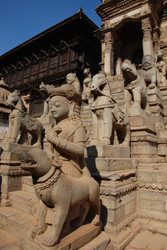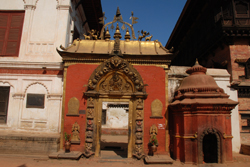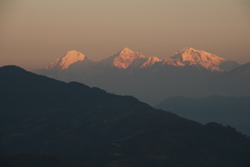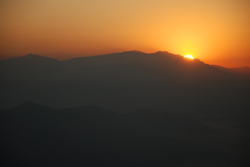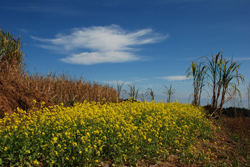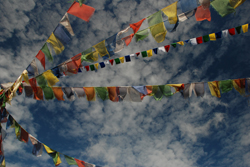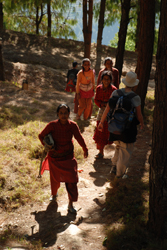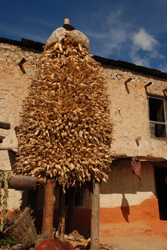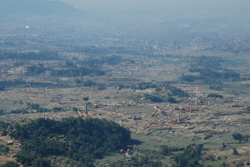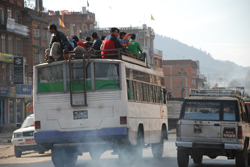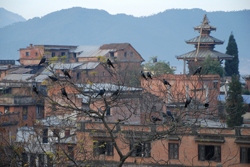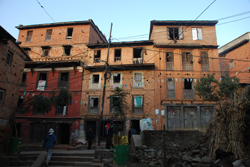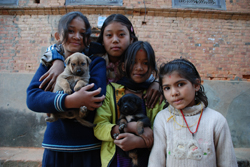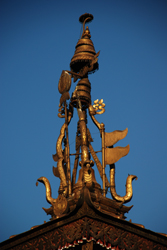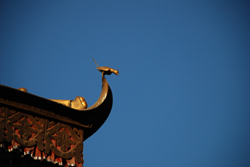Bouddhanath: Prayer Wheels and Spinning Shuttles
3 December, 2008, 03:43 am in "Nepal"
Bouddhanath, or Bouddha, is a Kathmandu suburb. At one point it was its own village but now it is hard to tell where Kathmandu ends and the former village begins. We took a very mini minivan there and as is the tradition with these things, they really pack you in. The conductor kept reaching through the window tugging on people's clothing to get them to move. We'd all do a little wiggle but since we were packed in with butts and legs squished together, no additional space was gained. I guess Rowshan's and my big foreigner butts threw their calculations off. They still managed to squeeze more people in but one of the last guys was partially sitting on the laps of the people next to him. Fortunately people got off and fewer people got on so aside from the long waits in traffic, the ride was tolerable.
The main reason to visit Bouddha is the Bouddhanath stupa, the largest stupa in Nepal and a UNESCO World Heritage Site. It is in the center of a plaza off the main street, a shining white structure whose brightness seems to add to the heat of the sun.
All around the stupa are souvenir shops, restaurants, thangka galleries (and schools) and guesthouses. The area also has several monasteries. Bouddha has become a center of Buddhism and a lot of Tibetan refugees have made it their home. At the edge of the square was a shrine with a huge prayer wheel.
We walked out of the square and headed towards the Kopan monastery. We passed a lot of metal workers, tailors, men and women spinning wool on wooden shuttle wheels, kids playing or returning from school in neat uniforms. We also saw yards where bunches of frames with what looked like some kind of treated cloth stood drying in the sun. We didn't know what they were at the time but now we think they may have been for making handmade paper.
The monastery is on the top of a tree covered hill. We took the car road which circled the hill-- a longer route but it gave us a view of all sides of the valley and the surrounding hills. The monastery was a peaceful, modern-looking place with a splendid view. Robed monks sat talking and we could hear young monks chanting.
At a large prayer wheel I read that prayer wheels are believed to help prevent disease, and bring peace to the world. It is a pretty thought but I am still skeptical. We still turned the wheel and make a point of turning other prayer wheels we come across. There is something peaceful, and meditative about it. On one of the monastery walls there was a quote from the 14th Dalai Lama about first having to change yourself and that would improve your family, and then the world.
Bhaktapur: A Cultural Center
2 December, 2008, 12:23 am in "Nepal"
The bus ride to Bhaktapur started out with a passenger arguing to the upbeat drum introduction to a Bollywood song played loudly by the driver. The scent of incense wafted through the bus. The man was kicked off then, perhaps borrowing his fare from someone outside, boarded peacefully and took a seat.
The bus filled as we reached Banepa. Then we headed to Bhaktapur. The bus jerked along blaring its horn as it passed other vehicles or stopped at a bus stop. Rowshan and I were watching an assembly line pass concrete or some other material up a ladder to the roof of a building when Shisher tapped his bag signaling we had to squeeze through the full bus to get out.
We walked through typical streets towards the historic center of Bhaktapur, making a stop at a ceramics workshop where a man in a dark shack made rough tiny dishes from black mud. Trays of dishes sat drying in the sun. I saw many were dented and realized why when a wandering chick stepped on one. Another man was covering the kiln with materials and dirt.
The historic part of town is quite large. It is easy to become overwhelmed by the large number of beautiful wood carved windows. The town was founded in the 12th century as a Malla kingdom. Bhakatapur, along with the other Malla kingdoms, Patan and Kathmandu battled over the Kathmandu valley. It became the dominant kingdom between the 14th and 16th centuries.
Bhaktapur is a bit of an artistic center. There are tons of thangka workshops, wood carvers and places that make handmade paper and cards. The town is famous for its Potter's Square which appears to be where all the ceramics in Nepal are made.
There are 3 main squares in the city. The first one we came to was Dattatraya which was the home to the large Dattatreya Temple. A little off the square was a beautifully carved peacock window.
It seemed that many of the the temples had carved erotic scenes underneath images of the gods. The second square we came upon was Taumadhi which is built around the Nyatapola Temple, a 5 storey temple which is the highest temple in Nepal.
The main square is called, as the other main squares in Nepali cities seem to be called, Durbar Square. It is filled with a number of temples but apparently, before the 1934 earthquake, contained even more. There is a palace named for its 55 windows with an ornate golden gate. Several of the temples are “guarded” by statues, such as the Siddhi Lakshmi Temple (has statues with dogs, people, horses, etc.) and the white Fasidega Temple. The styles ranged from terracotta one of the Char Dham temples, to Shiva.
Nagarkot Trek: Day 3 To Dhulikel: Himalayan Sunrise
1 December, 2008, 12:23 am in "Nepal"
Seeing the sunrise over the Himalayas is something I think everyone should do at least once in their lives. For us, it was the second time but it was still new miraculous and even better than the first. We left the hotel around 6:15 AM to rush to the viewing tower. As we were leaving we saw a woman and a guy rushing out in front of us. “Let's just go! I'm not going to wait around for him!” she angrily said. I thought she seemed grouchy and anxious. We left them behind as we rushed down the street.
The view into the valley was cloaked in a fog which softened the colors into an impressionist painting of pastel shapes against a yellow sky. We passed a tree where a solitary bird was perched singing-- not just a bird call of a few notes but something that sounded like a line from a folk song.
Himalaya's Singing Bird We reached the viewing tower and were able to watch the clouds in the valley drifting between mountains like rivers. There were other people at the tower. Everyone watched in silent reverence as the yellow, peaches and rose of the sky grew stronger and slowly touched the mountains with light. Everest is supposedly visible from Nagarkot as a dot peeking from behind a closer mountain. It was obscured by one of the few cloud banks in the sky. This cloud was the first to catch the light of the rising sun. There are 14 peaks in the world over 8000 meters and 8 of them are in Nepal. Far to the West, peeking from between the fir covered hills near Nagarkot is Manaslu, which was the first peak to catch the light of the sun. Langtang quickly followed, its triangular snow covered peak becoming a wash in gold. The mountains in the other ranges slowly caught the light, Ganesh Himaal seemed to rise from the edge of a hill. Finally the sun's fiery sphere appeared above the mountains. There are moments when the mountains shine in gold and rose. As the sun rises, its fire fades and spreads to light yellow and the clouds in the valleys begin to rise. Slowly the mountains start to be veiled in a light haze. The woman we saw at the hotel had reached the tower a few minutes after us. “Oh MY GOD!” she exclaimed looking at the 180 degrees of mountains. I wondered how she could break the silence maintained by everyone else. A few minutes later I heard her tell her friend, “This is exactly what I wanted!” I moved to a different part of the tower so I could silently view the beautiful shifting of light. Then I noticed her again beside me making sniffling noises. I turned, a bit annoyed until I noticed she was staring at the mountains and crying. At that moment, I realized she was fulfilling what must have been a strong dream for her. What I first interpreted as grumpiness was just anxiousness not to miss it. Her loud exclamations were from emotions. I almost envied her for being able to be so emotionally affected by the view. I was here almost by accident. I hadn't even thought about seeing the sun rise over the Himalayas. I was just lucky that things happened that way. Eagles had awakened and drifted above the trees. As the view began to be distorted by haze. After breakfast we headed up the road to a higher viewing tower. The valley was becoming clearer and the green and brown terraces were broken with splashes of bright yellow mustard flowers. The viewing tower was at the top of a hill. Garlands of colored prayer flags hung from the top to various points around it-- splashes of color against an ice blue sky. The viewing tower gave a perfect 360 degree view--180 of which is claimed by the Himalayas, the other 180 are the smaller mountains and foothills surrounding the Kathmandu Valley. As we walked down the trail, through tall straight pines, Shisher would often whistle or sing a Nepalese folk song. Rowshan would pick it up. On other parts of the trail we would often hear the sounds of people singing or whistling as they walked. Sometimes we would pass a group of Nepalese women, striking in their red saris, cloaks, pants and gold nose rings and jewelry. I loved how they would smile and reply to my “namaste” and then giggle as Rowshan took their photos. The village of Sural was a cluster of stone houses and small wood platforms holding trees of dry corn ears. From there we had a view into the Kathmandu Valley and Bhaktapur which was striking for its multiple smoke stacks of the brick factories. They were spaced evenly and regularly as if they were telephone poles along a road. Kathmandu was hidden from view by a dense layer of smog. Once on the valley floor the land became completely flat and the rice fields appeared. People were busy harvesting potatoes. The white bags of potatoes looked like ghosts compared to the bright colored clothing worn by the people working. We passed several Hindu shrines-- small fountains with images of Ganesh. Soon we were walking down a dusty street getting closer to the city Banepa. Trucks sent clouds of dust up. Egrets fed on insects in the fields. Banepa was a busy, unattractive city with tall brick buildings under various phases of construction. Women sat on the ground with small hammers breaking rocks. Around them were piles of various sizes of rock ranging from tiny pebbles on up. Shisher pointed to concrete rings in another part of the yard and said the women were breaking rocks to make concrete. I can't imagine how much physical labor a few feet of concrete would consume. The main street was a dusty, busy street where buses raced by blaring their horns. As we had lunch I saw a bus speed by with a goat standing on the roof. People sometimes ride on the roofs as well though it is illegal in the Kathmandu Valley. I wondered how they managed to fasten the goat to the roof enabling it to stand but not get thrown off with every sharp turn and veering motion the bus made. We boarded a bus which quickly zigged and zagged along a straight road up the hill to Dhulikel. I wondered how the human passengers on top managed to keep from flying off. At first Dhulikel seemed a disappointment. The bus stopped in a dusty street with brick buildings and lots of buses speeding by. The air was smoggy and the Himalayas were hidden by smog and clouds. Our hotel was damp and hadn't been cleaned in a while. Still, the sight of a temple roof not far from the hotel gave us hope. As we walked towards the temple, things began to look up. The old town is full of traditional Newari architecture. Flagstoned streets led between old buildings with beautiful carved wooden screens. In the courtyard of a the Bhagwati temple, kids played the Nepali version of hacky sack using a bundle of rubber bands (often cut up strips of old bicycle innertubes.) Many of the buildings in the old town looked as if they were almost abandoned. Perhaps people are moving to the new brick buildings in the new part of town by the highway. The streets were wonderful to wander through. They were quiet, people sat by the street working or relaxing. A group of kids posed for a photo. A little down the street I heard drumming. The drummer was a tiny boy wearing a traditional Nepalese drum. He eagerly beat his drum smiling as if it was a new present. When he saw the other kids being photographed he raced over to Rowshan's delight as well as his own. We wandered through more streets and found another shrine. There I was frisked by a kid looking for “one choclo” who was sure I was hiding some in either my right or left coat pocket. Beyond that we came to a square with a temple to Vishnu and the Hari Siddhi temple. The roofs of the temples were adorned with metal birds on the corners and snakes on the top. There was also a little white stupa. Men played cards on a shade platform in the center of the square. Another man dressed in a loin cloth led a herd of buffalo through. In front of the Vishnu temple was a Hanuman statue cloaked in red. After our stroll around town we went back to the hotel and watched the sun set from the roof. The mountains remained hidden by the clouds until strangely just as the sun was setting, 2 snow capped peaks were visible shining pink in the clouds. A minute later they were gone.
Powered by My Blog 1.69. Copyright 2003-2006 FuzzyMonkey.net.
Created by the scripting wizards at FuzzyMonkey.net.. (Code modified by Rowshan Dowlatabadi) |


